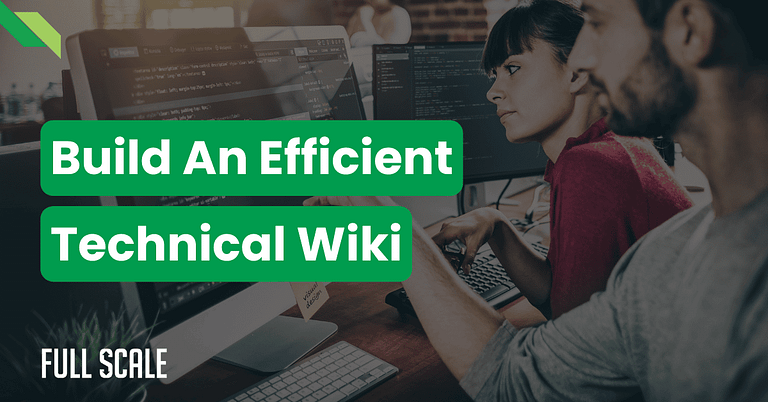The cost of lost knowledge is staggering yet often invisible on balance sheets. Don’t you agree?
According to recent research by Gitlab, engineers spend an average of 6.5 hours per week simply looking for information or duplicating work that already exists somewhere in the organization. That’s nearly 17% of productive time wasted due to knowledge silos.
A mid-sized engineering team of 50 developers earning an average of $150,000 annually effectively loses over $1.25 million yearly productivity due to poor documentation practices. It sounds crazy, but the numbers don’t lie.
So, when one of our clients, a fintech startup, implemented a structured developer wiki, they reduced onboarding time from 12 weeks to just 3 weeks. This 75% improvement allowed new engineers to ship their first production code three times faster.
Despite these compelling numbers, technical wikis and knowledge management systems frequently fail to deliver on their promise.
The issue isn’t merely technological. It’s fundamentally about understanding how developers work and creating systems that enhance rather than obstruct their workflows.
Why Do Most Technical Wikis Fail? Let’s Understand the Engineer’s Mindset
Despite significant investments in documentation platforms, most organizations struggle with low adoption rates among their engineering teams.
At StackOverflow, a survey of 1,200 developers revealed that 84% prefer asking colleagues directly over consulting internal technical wikis. Why is that?
Turns out, the answer was simple. Engineers don’t value documentation because most documentation systems fundamentally misunderstand how developers work.
The engineering mindset revolves around efficiency, context preservation, and tool integration.
Technical wikis that ignore these core principles inevitably gather digital dust. After analyzing dozens of failed documentation initiatives across companies ranging from early-stage startups to Fortune 500 enterprises, clear patterns emerge that explain why engineers resist using existing technical wikis.
- Workflow Disruption: Engineers operate in IDEs, terminals, and version control systems. Documentation platforms that exist outside these environments create context-switching costs.
- Maintenance Friction: In a recent survey of 500 software engineers conducted by Stack Overflow, 78% cited “outdated information” as the primary reason they don’t trust internal documentation.
- Searchability Issues: 65% of developers report spending more time searching for information than actually reading it once found.
- Ownership Ambiguity: Without clear responsibilities for specific documentation areas, content quickly becomes orphaned.
- Tool Fragmentation: When documentation exists across Confluence, Notion, Google Docs, READMEs, and comments, engineers default to asking colleagues instead.
The parallel to technical debt is striking—documentation debt accumulates silently but extracts an increasingly heavy toll on productivity as organizations scale.
Foundations of a Developer-Centric Wiki Strategy
To create a technical wiki that engineers actually use, we must align with developer workflows rather than fighting against them.
This means embracing documentation as code principles, where documentation lives alongside the code it describes.
Documentation as Code: The Core Paradigm Shift
The fundamental breakthrough in modern technical documentation comes from treating docs with the same rigor as production code.
This “documentation as code” approach integrates documentation directly into the development workflow rather than treating it as a separate activity.
When Stripe Engineering faced documentation chaos across 300+ microservices, it revolutionized its approach by applying software engineering principles to knowledge management.
Their transformation centered around four key principles that any organization can adopt.
- Version Control Integration: Documentation changes are tracked alongside code changes, using the same Git workflows
- IDE-Friendly Formats: Documentation in Markdown or AsciiDoc allows engineers to update docs in their familiar editing environment
- Review Processes: Documentation changes undergo peer review just like code changes
- Automation: Documentation tests verify links, examples, and ensure standards compliance
This approach reduced documentation update time by 64% in their organization and increased documentation accuracy by over 40%.
How to Select the Right Wiki Platform for Your Technical Architecture
The foundation of an effective technical wiki is selecting tools that integrate seamlessly with existing engineering workflows. Here’s a comparative analysis of approaches that have proven successful.
Git-Based Documentation
Platforms like Docusaurus, MkDocs, and GitBook allow documentation to live alongside code in repositories. These systems offer:
- Familiar workflow for developers (pull requests for changes)
- Version control and change history
- Deployment via CI/CD pipelines
- Markdown-based authoring
Enhanced Enterprise Platforms
For larger teams with complex needs, platforms like Confluence, Notion, or Document360 offer robust features but require more customization to align with developer workflows.
- More powerful access controls and permissions
- Enhanced collaboration features
- Better support for non-technical contributors
- Advanced search capabilities
- Integration with issue-tracking systems
Open-Source Alternatives
Open-source wiki tools for developers like BookStack, Wiki.js, and DokuWiki provide customizable solutions without vendor lock-in.
- Self-hosted options for data control
- Extensibility through plugins
- Community support
- Lower cost of ownership
When Shopify evaluated Wiki vs. Confluence vs. Notion for engineers, they ultimately built a custom system that combined Git-based workflows with rich search capabilities.
Your specific integration needs, team size, and existing toolchain should guide your choice.
Structuring Your Technical Wiki for Maximum Utility
The information architecture within your technical wiki is as essential as the platform itself. A well-structured technical wiki improves findability and maintains relevance.
1. Consistent Template System: Standardize document structures for common content types:
- API Documentation
- Architecture decision records
- System diagrams
- Troubleshooting guides
- Onboarding materials
2. Intuitive Taxonomy: Organize content by:
- System/product area (not by team, which changes)
- Information type (reference, how-to, conceptual)
- Audience (new developers, system experts)
3. Strong Metadata Strategy: Tag content with:
- Related systems
- Required knowledge prerequisites
- Last verified date
- Responsible maintainers
When MongoDB implemented this structured approach, search time for specific documentation decreased by 83%, and engineers reported 71% higher satisfaction with internal documentation.
Automation: The Key to Sustainable Documentation
Manual documentation inevitably becomes outdated. Automation ensures accuracy and reduces maintenance burden.
Effective Automation Strategies
- API Documentation Generation: Tools like Swagger/OpenAPI for REST APIs or GraphQL introspection automatically keep API documentation current with the actual implementation
- Code Integration: Systems like JSDoc, Javadoc, or Sphinx extract documentation from code comments
- Diagram Generation: Infrastructure-as-code tools can automatically generate system architecture diagrams
- Status Indicators: Integrate with monitoring systems to show real-time service status alongside documentation
- Freshness Verification: Automated checks that flag documentation not updated within a specific timeframe
Twilio’s engineering team implemented documentation automation that reduced maintenance time by 62% while improving accuracy by 45%.
Their system automatically flags any documentation not updated when related code changes.
Creating a Documentation-First Engineering Culture
Even the most sophisticated technical wiki platform will fail without the right engineering culture to support it.
At Netflix, engineers discovered that documentation adoption increased by 380% when it became a valued part of their technical identity rather than an administrative burden.
Cultural transformation—not just tooling—determines whether documentation becomes a thriving knowledge ecosystem or an abandoned digital graveyard.
Leading engineering organizations recognize that making documentation part of dev culture requires deliberate leadership, integrated workflows, and tangible recognition systems.
1. Start With Leadership
- Engineering leaders must visibly value and contribute to documentation
2. Integrate With Existing Practices
- Include documentation requirements in code review checklists
- Add documentation user stories to sprints
- Create documentation acceptance criteria for feature completion
3. Measure and Reward
- Track documentation contributions in performance reviews
- Celebrate exceptional documentation
- Share impact metrics (e.g., “This documentation saved the team 20 hours last month”)
4. Documentation Champions Program
- Identify documentation advocates within each team
- Provide additional training and tools
- Allocate dedicated time for documentation improvement
5. Provide Training
- Technical writing workshops for engineers
- Clear guidelines and examples
- Templates and starter structures
When Shopify implemented its Documentation Champions program, technical wiki contributions increased by 215% within six months. And the number of engineers who reported being blocked by missing documentation dropped by 68%.
5 Best Practices for Technical Content Creation
Effective technical documentation is the backbone of successful engineering teams.
Whether it’s API references, system architecture guides, or onboarding manuals, well-structured documentation accelerates development, minimizes confusion, and reduces dependency on individual contributors.
However, engineers often struggle with writing clear, concise, and user-friendly content—resulting in scattered, outdated, or overly complex documentation that hinders productivity.
1. Structure Content for Scanability
- Start with the most important information
- Use descriptive headings and subheadings
- Include a table of contents for longer documents
2. Write Clear, Concise Procedures
- Step-by-step instructions with expected outcomes
- Command-line examples with expected output
- Common troubleshooting steps
3. Incorporate Visual Elements
- System diagrams
- Sequence diagrams for complex processes
- Screenshots for UI-related features
4. Code Examples That Work
- Tested, functional code snippets
- Explanations of why, not just how
- Links to working implementations
5. Markdown Best Practices
- Consistent formatting
- Proper heading hierarchy
- Judicious use of emphasis and code formatting
Stripe’s documentation quality increased by 53% after implementing structured writing guidelines and templates, leading to a 47% reduction in repeated questions on internal channels.
Key Metrics Framework: Measure Success and Drive Adoption in Four Aspects
Creating technical documentation is only the first step—ensuring its effectiveness and widespread adoption truly makes it valuable.
Without clear success metrics, teams may struggle to identify gaps, improve content, or justify ongoing documentation efforts.
1. Usage Metrics
- Page views and unique visitors
- Search queries and click-through rates
- Time spent on pages
2. Content Quality Indicators
- Feedback scores
- Edit frequency
- Link integrity
3. Business Impact Metrics
- Reduction in support tickets
- Decrease in onboarding time
- Time saved (via surveys)
4. Contribution Metrics
- Number of contributors
- Frequency of updates
- Distribution across teams
GitHub’s internal engineering team created a weekly “Documentation Impact Report.” It highlights how documentation improvements directly correlate with reduced incident resolution times.
Moreover, faster feature development helps secure ongoing investment in their knowledge management systems.
Success Stories of Effective Technical Wiki
When global payment processor Adyen set out to rebuild its technical wiki, it wasn’t just about organizing information.
It was about creating a culture of documentation that empowered engineers to collaborate more efficiently.
The Challenge
With 600+ engineers across 25 teams, Adyen struggled with fragmented documentation across Confluence, Google Drive, and various READMEs.
New engineers took an average of 16 weeks to become fully productive, and knowledge was heavily siloed within teams.
The Solution
Adyen implemented a Git-based documentation system with the following key features:
- Proximity to Code: Documentation lived in the same repositories as the code it described.
- Automated Verification: Integration tests ensured documentation examples remained functional.
- Standardized Templates: Common document types followed consistent structures.
- Central Search: A unified search interface indexed all documentation sources.
- Documentation Owners: Each system had designated documentation maintainers.
The Results
Within 12 months of implementation:
- Onboarding time decreased by 62% (from 16 weeks to 6 weeks)
- Engineers reported saving 5.2 hours per week previously spent searching for information
- Documentation coverage increased from 43% to 87% of systems
- Cross-team contributions to documentation increased by 340%
- Incident resolution time decreased by 28% due to better troubleshooting documentation
The estimated annual productivity gain exceeded $3.8 million, with an implementation cost of approximately $420,000.
Advanced Considerations for Scaling Technical Documentation
As organizations grow, documentation needs evolve. Advanced approaches ensure scalability.
AI-Assisted Documentation
Tools like GitHub Copilot for documentation can suggest improvements, identify gaps, and even generate initial documentation drafts from code.
Machine Learning for Maintenance
ML algorithms can identify potentially outdated documentation by analyzing code changes, usage patterns, and age.
Scaling Across Multiple Teams
For large organizations:
- Federated documentation models
- Cross-linking between team-specific wikis
- Global standards with team-specific implementations
- Translation services for global teams
Documentation Debt Management
Like technical debt, documentation debt requires explicit management:
- Regular documentation sprints
- Documentation quality scoring
- Deprecation policies for outdated content
- Archiving strategies that preserve historical knowledge while highlighting current content
The Competitive Advantage of Effective Documentation
In today’s engineering organizations, effective knowledge management is not merely an operational nice-to-have—it’s a strategic advantage.
Teams with superior documentation onboard engineers faster, resolve incidents more quickly, build more consistent systems, and ultimately deliver better software more rapidly.
Organizations can unlock trapped knowledge, reduce costly redundant work, and create more resilient engineering teams by treating documentation as a first-class engineering artifact with the same attention to process, quality, and automation as code itself.
The most successful technical wikis succeed not because they have the most features or the slickest interface but because they understand the engineer’s workflow and enhance rather than obstruct it.
Get Your Engineering Team on the Same Page
Building and maintaining a technical wiki is just one piece of the puzzle. Scaling your engineering team efficiently is another.
At Full Scale, we specialize in helping fast-growing companies like yours accelerate development without sacrificing quality.
Our pre-vetted offshore developers seamlessly integrate with your team. We can ensure your documentation stays relevant, your processes smooth, and your engineers productive.
Need expert developers to build and maintain high-quality systems?
Get Your FREE Consultation Today
Frequently Asked Questions (FAQs)
1. Why do most technical wikis fail?
Most technical wikis fail due to low adoption rates, outdated content, poor searchability, and lack of ownership. Engineers often prefer asking colleagues instead of searching for documentation because many wikis disrupt their workflow or contain stale information.
2. How do I encourage engineers to contribute to the wiki?
Encourage contributions by integrating documentation into existing workflows, such as using documentation-as-code principles, assigning ownership to specific teams, and providing incentives like recognition or performance metrics.
3. What are the best platforms for building a technical wiki?
The best platform depends on your engineering workflow. Git-based tools (Docusaurus, MkDocs, GitBook) integrate well with version control, while enterprise solutions (Confluence, Notion, Document360) offer rich collaboration features. Open-source options like Wiki.js and DokuWiki provide flexibility for self-hosting.
4. How can we keep our wiki up to date?
Use automation to update API documentation, validate links, and flag outdated content. Implement review processes similar to code reviews and schedule documentation sprints to ensure accuracy.
5. What’s the best way to structure a technical wiki?
Use a consistent template system for different document types (API docs, troubleshooting guides, onboarding materials), organize content by system/product area, and implement strong metadata tagging to improve searchability.
6. How do I measure the success of a technical wiki?
Track usage metrics (page views, search queries, time spent), content quality indicators (feedback scores, update frequency), and business impact metrics (onboarding speed, time saved, reduced support tickets).
7. What’s the difference between a wiki and Confluence/Notion for engineers?
Wikis offer open, flexible structures, whereas Confluence and Notion provide structured collaboration tools with access controls, integrations, and team-oriented features. Engineers may prefer Git-based wikis for better version control and workflow integration.
8. How do we integrate a wiki with developer tools?
Use API-based integrations with tools like Slack, Jira, and GitHub to surface relevant documentation in workflows. Choose IDE-friendly formats like Markdown to allow engineers to update documentation without switching contexts.
9. How can we reduce knowledge silos in our engineering team?
Encourage cross-team collaboration, use a federated documentation model (where teams own specific sections), and implement searchable, centralized knowledge bases to prevent critical knowledge from being isolated within teams.
10. Can a technical wiki help with onboarding new developers?
Yes! A well-structured technical wiki can accelerate onboarding by providing a self-service knowledge base, reducing dependency on senior engineers, and enabling new hires to find information quickly.

Matt Watson is a serial tech entrepreneur who has started four companies and had a nine-figure exit. He was the founder and CTO of VinSolutions, the #1 CRM software used in today’s automotive industry. He has over twenty years of experience working as a tech CTO and building cutting-edge SaaS solutions.
As the CEO of Full Scale, he has helped over 100 tech companies build their software services and development teams. Full Scale specializes in helping tech companies grow by augmenting their in-house teams with software development talent from the Philippines.
Matt hosts Startup Hustle, a top podcast about entrepreneurship with over 6 million downloads. He has a wealth of knowledge about startups and business from his personal experience and from interviewing hundreds of other entrepreneurs.





